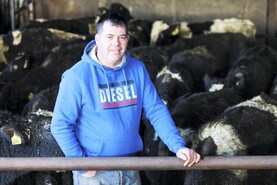Banks are reporting increased applications from farmers for loans, especially around land purchase in recent months. To start looking at interest rates available, I return to a survey we carried out in late November with a number of beef, sheep and dairy farmers around the country. The interest rates were the actual rates they were being charged in late November.
The average overdraft interest rate in the survey was 7.1%. Figure 1 shows the range of what farmers are paying.
The lowest rate is 1.625%, a deal that was obviously still linked to the Euribor rate. Some farmers still on these are finding rates jumping to over 4% when they go to renew.
At the other end of the scale, there were more farmers on 8%, with the most expensive overdraft close to 12%.
This would tie in to the fact that overdraft rates being offered are between 7% and 9%.
The average for the surveyed farmers’ term loans was 4.07%. As always, the range in term loans is tighter than the overdraft rates. The highest rates were around 6.8%. A number of the lowest rates were clearly locked in at 1% to 2% over the Euribor a number of years ago. Again, deals as low as 1.625% and tied to the Euribor are no longer available.
Banks have moved away from this, linking variable rates to the bank prime rate, which is the Euribor rate plus an additional margin. It is less transparent than the Euribor rate as the banks can vary the margin they add over time.
Stocking loans and business credit varied from 4.5% to 5.4% but, in one case, a hire purchase deal was done at 9.7%.
It is important that you have a clear plan on restructuring and repayments set out before going into the bank.
It is worth getting your accountant or adviser to go through it with you. In serious cases, it is vital that they attend the meeting with the bank.
Extra costs
Some farmers are also finding that banks are looking for a fee to draw up loans. They are being forced to pay for two sets of solicitors – their own and the banks. In some cases, the bank is giving a sum toward the setting up cost.
The interest rate a farmer pays is not only a reflection of his negotiating skills, it is also a reflection of the amount of money involved and the quality of the farmer’s business, as well as the proposal he puts to the bank.
Banks look at four main elements when setting interest rates:
Repayment capacity – based on farm accounts and what is available to service borrowing. Banks are looking at the impact of CAP reforms on farmers’ direct payments over the next five years. Current account – how has your cashflow been managed in the past? Equity in the business – how much is the farmer putting in for the project he/she is borrowing for? Security – must be valuable, saleable or assignable. Land is still good but values have reduced. Farmers should look to minimise security by offering outfarms or splitting off sites from the main farm.Tips: Get better interest rates
Know your rates: What are you being charged? How does this compare with what’s available? This survey gives you an idea but rates are creeping up. Know your business: Do cashflow projections and identify cash surpluses. No surprises: Manage your cashflow, don’t go over limits, make all repayments on time.Use professional advice if you need to: Make sure you understand it as well.Be prepared to change banks: There are signs that banks are willing to take on new customers and one farmer in the survey had moved.Checklist for bank meeting
Cashflow budget – is it completed and based on sound projections? Have you put in living expenses? Recent accounts – you should have 2013 accounts at this stage. Do you understand the key information contained in them? Stock numbers – have a list of your up-to-date stock numbers.List of money you are owed and money you owe – list out the creditors that owe you money and the debtors who you owe money to. Bring in the most recent co-op or merchant statements. Have a list of your requirements – this could be from an increased overdraft to a plan to restructure loans. Have it well thought-out and know the reason you are asking. It could be prepared by your accountant or adviser. This is recommended if you already have financial problems or see them ahead.Security – what will you give and how much will it cost? Banks are asking farmers to cover the cost of their solicitors as well.Support – you can ask your adviser or accountant to come to the meeting with you. This is advised if you foresee problems.
Banks are reporting increased applications from farmers for loans, especially around land purchase in recent months. To start looking at interest rates available, I return to a survey we carried out in late November with a number of beef, sheep and dairy farmers around the country. The interest rates were the actual rates they were being charged in late November.
The average overdraft interest rate in the survey was 7.1%. Figure 1 shows the range of what farmers are paying.
The lowest rate is 1.625%, a deal that was obviously still linked to the Euribor rate. Some farmers still on these are finding rates jumping to over 4% when they go to renew.
At the other end of the scale, there were more farmers on 8%, with the most expensive overdraft close to 12%.
This would tie in to the fact that overdraft rates being offered are between 7% and 9%.
The average for the surveyed farmers’ term loans was 4.07%. As always, the range in term loans is tighter than the overdraft rates. The highest rates were around 6.8%. A number of the lowest rates were clearly locked in at 1% to 2% over the Euribor a number of years ago. Again, deals as low as 1.625% and tied to the Euribor are no longer available.
Banks have moved away from this, linking variable rates to the bank prime rate, which is the Euribor rate plus an additional margin. It is less transparent than the Euribor rate as the banks can vary the margin they add over time.
Stocking loans and business credit varied from 4.5% to 5.4% but, in one case, a hire purchase deal was done at 9.7%.
It is important that you have a clear plan on restructuring and repayments set out before going into the bank.
It is worth getting your accountant or adviser to go through it with you. In serious cases, it is vital that they attend the meeting with the bank.
Extra costs
Some farmers are also finding that banks are looking for a fee to draw up loans. They are being forced to pay for two sets of solicitors – their own and the banks. In some cases, the bank is giving a sum toward the setting up cost.
The interest rate a farmer pays is not only a reflection of his negotiating skills, it is also a reflection of the amount of money involved and the quality of the farmer’s business, as well as the proposal he puts to the bank.
Banks look at four main elements when setting interest rates:
Repayment capacity – based on farm accounts and what is available to service borrowing. Banks are looking at the impact of CAP reforms on farmers’ direct payments over the next five years. Current account – how has your cashflow been managed in the past? Equity in the business – how much is the farmer putting in for the project he/she is borrowing for? Security – must be valuable, saleable or assignable. Land is still good but values have reduced. Farmers should look to minimise security by offering outfarms or splitting off sites from the main farm.Tips: Get better interest rates
Know your rates: What are you being charged? How does this compare with what’s available? This survey gives you an idea but rates are creeping up. Know your business: Do cashflow projections and identify cash surpluses. No surprises: Manage your cashflow, don’t go over limits, make all repayments on time.Use professional advice if you need to: Make sure you understand it as well.Be prepared to change banks: There are signs that banks are willing to take on new customers and one farmer in the survey had moved.Checklist for bank meeting
Cashflow budget – is it completed and based on sound projections? Have you put in living expenses? Recent accounts – you should have 2013 accounts at this stage. Do you understand the key information contained in them? Stock numbers – have a list of your up-to-date stock numbers.List of money you are owed and money you owe – list out the creditors that owe you money and the debtors who you owe money to. Bring in the most recent co-op or merchant statements. Have a list of your requirements – this could be from an increased overdraft to a plan to restructure loans. Have it well thought-out and know the reason you are asking. It could be prepared by your accountant or adviser. This is recommended if you already have financial problems or see them ahead.Security – what will you give and how much will it cost? Banks are asking farmers to cover the cost of their solicitors as well.Support – you can ask your adviser or accountant to come to the meeting with you. This is advised if you foresee problems. 





 This is a subscriber-only article
This is a subscriber-only article









SHARING OPTIONS: